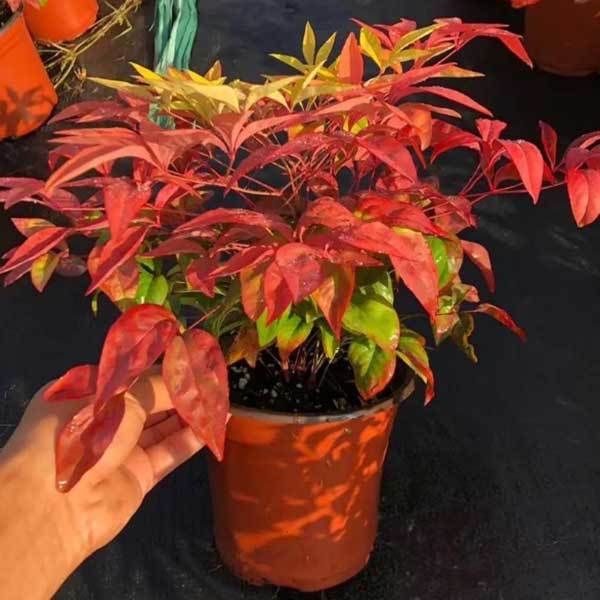Understanding and Resolving Nandina Leaves Turning Brown
Introduction
Nandina, also known as heavenly bamboo, is a popular ornamental plant. However, nandina leaves turning brown indicate an underlying problem that needs attention. Use these tips to determine the cause and take appropriate action.
Why are My Nandina Leaves Turning Brown?
Environmental Factors
Extreme Temperatures: Nandina is a hardy plant. But it is susceptible to damage from both hot and cold temperatures. Your nandina leaves may turn brown if your area is extremely hot or cold.
Sunlight and Shade: Nandina thrives in partial shade but can also tolerate full sun. The leaf may burn or discolor if the plant receives too much or too little sunlight.
Soil Conditions: Nandina prefers well-draining soil rich in organic matter. If the soil is too compact or lacks nutrients, it can cause stress on the plant and result in nandina brown leaves.
Watering Issues
Overwatering: It can lead to root rot and other fungal diseases. So don't keep the soil too moist for a long time. It is an ideal environment for fungi. The roots won't absorb nutrients and oxygen. This leads to nandina leaves turning yellow and brown.
Underwatering: When a plant doesn't receive enough water, it will start to conserve its resources by discarding old or damaged leaves. This is known as "drought stress" and can lead to the browning of leaf edges and tips.
Pests and Diseases
Identifying Common Pests: Twospotted spider mites are tiny insects. They feed on the leaves, sucking out the plant's juices. They can quickly multiply and spread to neighboring plants if left untreated. Hemispherical scales attach themselves to the stems and leaves of the plant, sucking out its sap. This can lead to the leaves turning yellow or brown and falling off.
Recognizing Common Diseases: Leaf spots can appear as dark spots on the leaves and eventually cause them to dry up and die. Powdery mildew appears as a white powder-like substance on the leaves. It can also cause them to curl and turn brown.
Pruning Mistakes
Incorrect Pruning Techniques: Incorrect techniques include using dull or dirty tools. This can cause tearing and damage to the plant. You should use sharp, clean tools and make precise cuts. Avoid creating entry points for pests and diseases.
Timing of Pruning: Timing is also crucial when pruning nandina plants. Pruning at the wrong time can shock the plant. It is recommended to prune nandina plants during their dormant season, typically in late winter or early spring.

Resolving Nandina Leaves Turning Brown
Correcting Environmental Factors
Adjusting Planting Locations: Move your nandina plant to a shadier location if it receives too much direct sunlight. Similarly, if the plant is not getting enough sunlight, you may need to relocate it to a spot with more direct light. Additionally, excessive wind or frost exposure can also cause leaves to turn brown.
Soil Amendments: Nandina plants prefer well-draining soil that is slightly acidic. If your plant is not receiving the proper nutrients or if the pH level of the soil is off, this could be contributing to nandina leaves turning brown. Consider adding organic matter or using a fertilizer specifically designed for acid-loving plants to help correct these issues.
Watering Strategies
Proper Watering Techniques: Always water at the base of the plant, avoiding the leaves. Water deeply but infrequently, allowing the soil to dry out between waterings. You can use a drip irrigation system or a soaker hose. This can give you plants more efficient and targeted watering.
Watering Schedule: In hot, dry weather, water every 3-5 days. In cooler, humid weather, water every 7-10 days. Adjust watering frequency as needed based on the moisture level of the soil.
Dealing with Pests and Diseases
Natural Remedies vs. Chemical Treatments: Natural remedies include using insecticidal soap, neem oil, or introducing beneficial insects to your garden. On the other hand, chemical treatments involve using pesticides and fungicides specifically designed for nandina plants.
Natural remedies may take longer to show results. But they are safer for the environment and do not harm beneficial insects. Chemical treatments provide quicker results. But they will harm beneficial insects and the environment if you use them improperly.
Preventative Measures: Regularly inspect your plants for any signs of infestation or disease. Promptly address them using natural remedies or chemical treatments. Also, make sure to plant your nandina in well-drained soil. They should receive the proper amount of sunlight.
Proper watering and fertilization can also keep the plants healthy. They will not be easily affected by pests and diseases. Practicing good garden hygiene can prevent pests from making a home on your nandina plants. For example, remove any fallen leaves or debris.
Pruning Techniques
Correct Pruning Methods: Assess the plant and identify any damaged or diseased branches. Remove them with clean, sharp pruning shears. Make clean cuts at a 45-degree angle just above a leaf node to encourage new growth.
Seasonal Pruning Tips: In the winter months, prune away any dead or damaged branches to promote new growth in the spring. In the spring, prune for shape and to thin out overcrowded areas of the plant. In the summer, lightly prune to tidy up the plant and remove any unwanted growth. In the fall, avoid pruning as this is when nandina produces its vibrant red berries for winter interest.
Conclusion
You should understand the underlying causes. Take appropriate measures. Your nandina plant's leaves will restore their vibrant green color.

